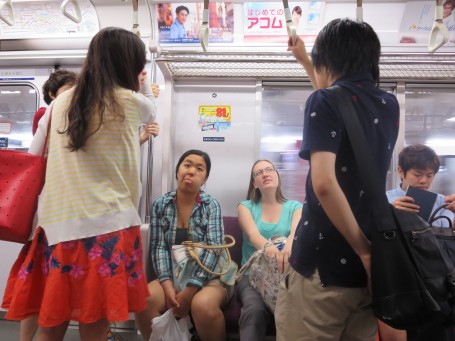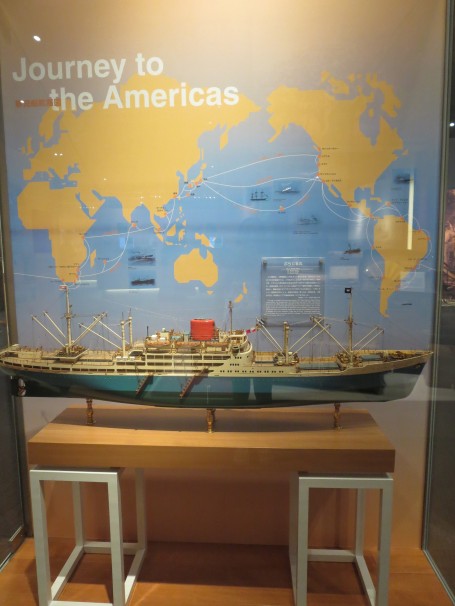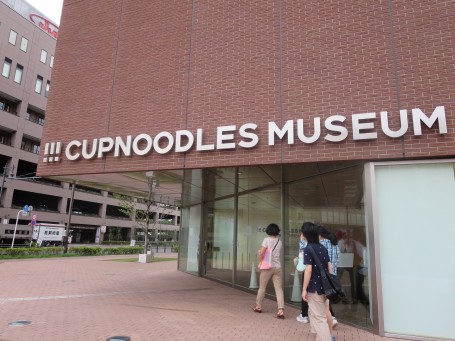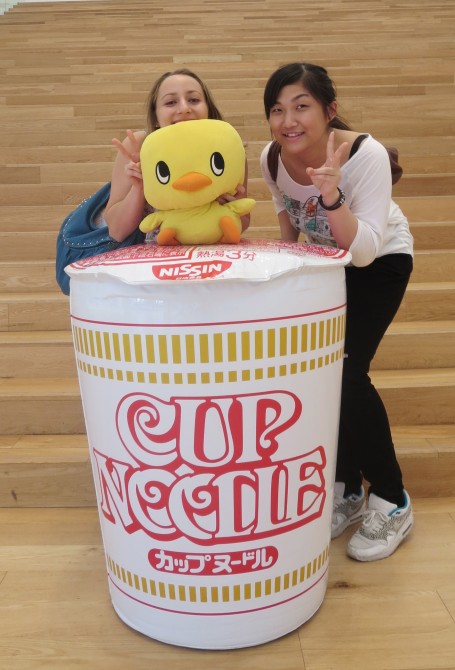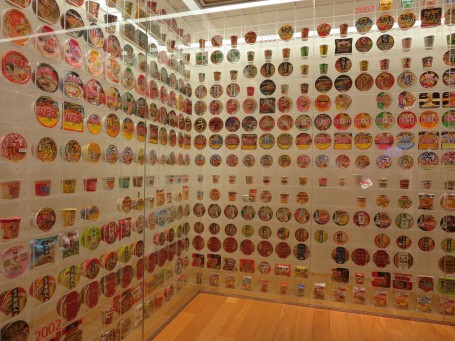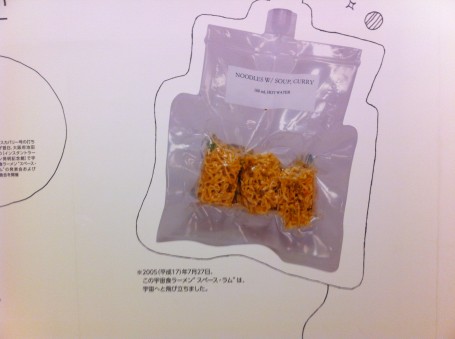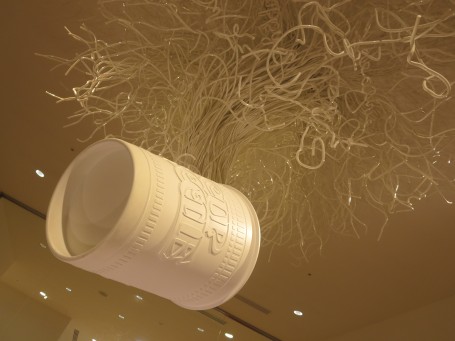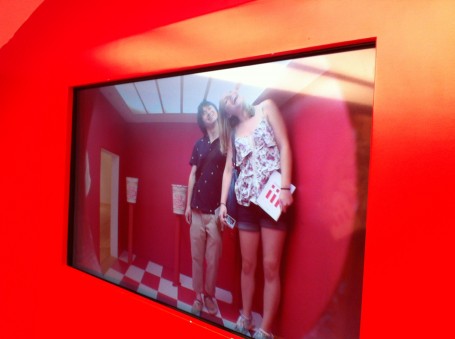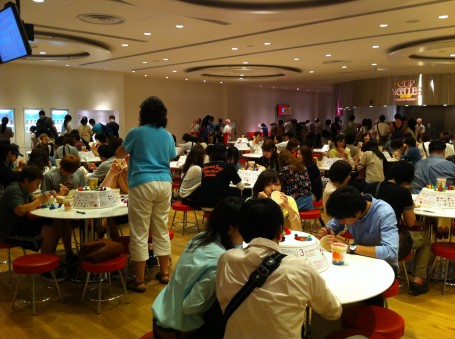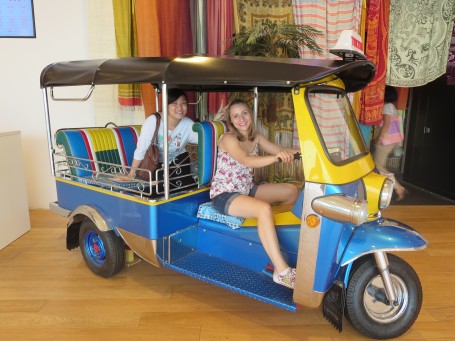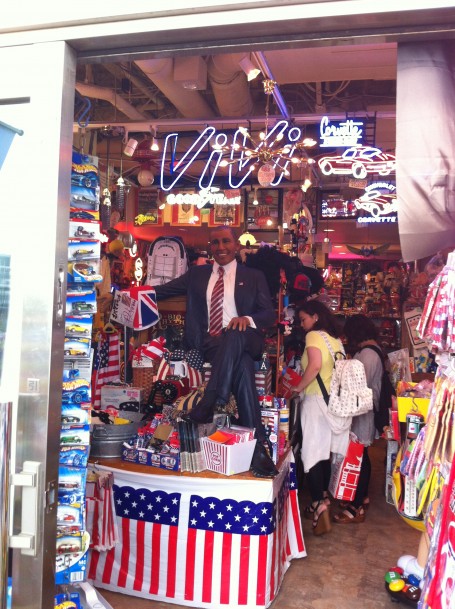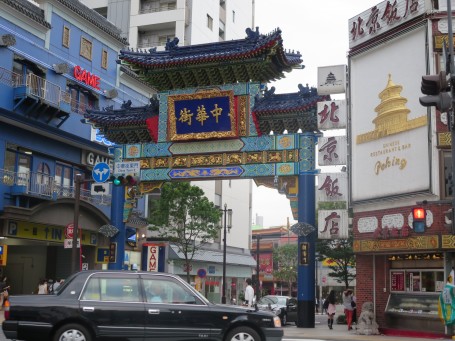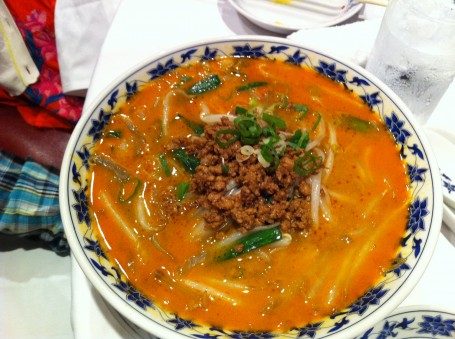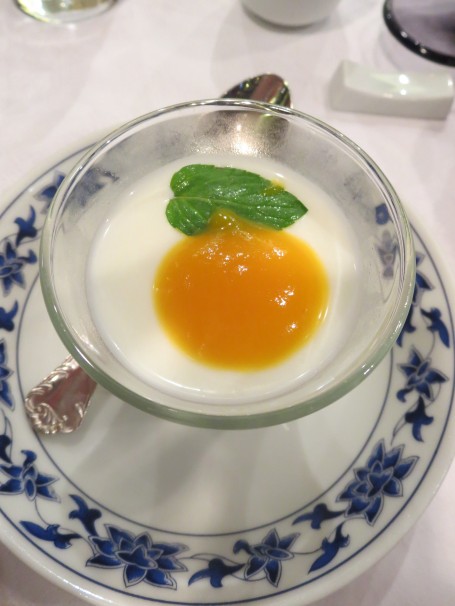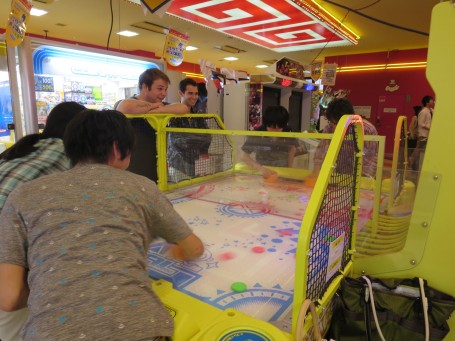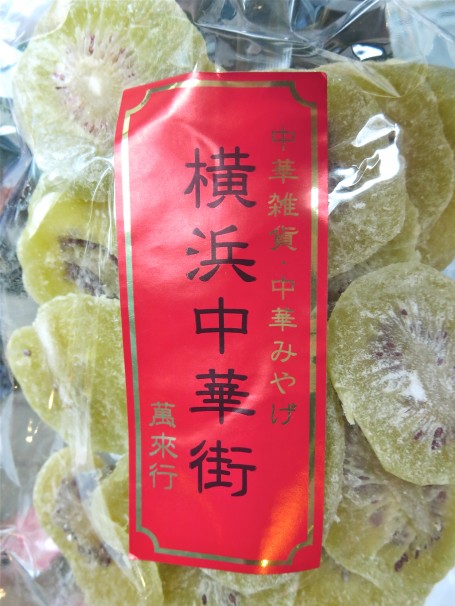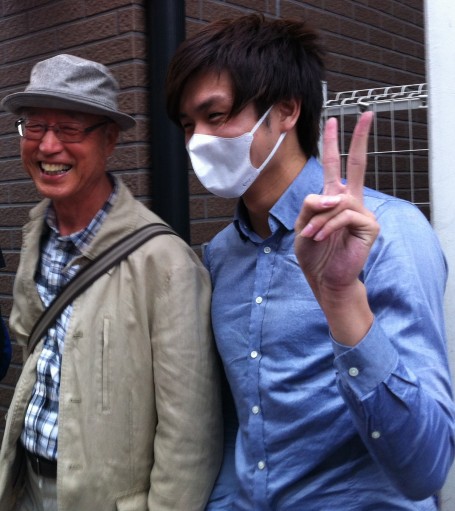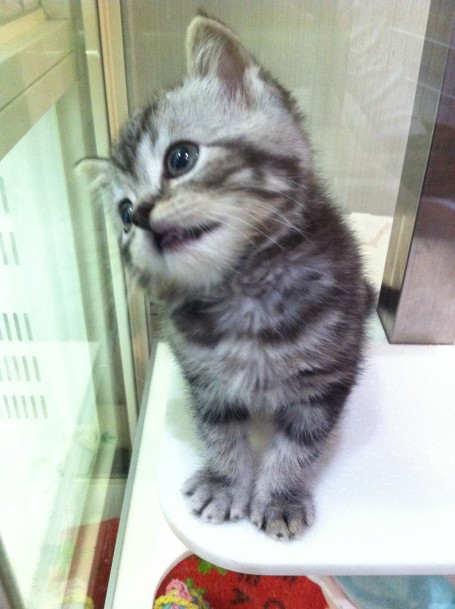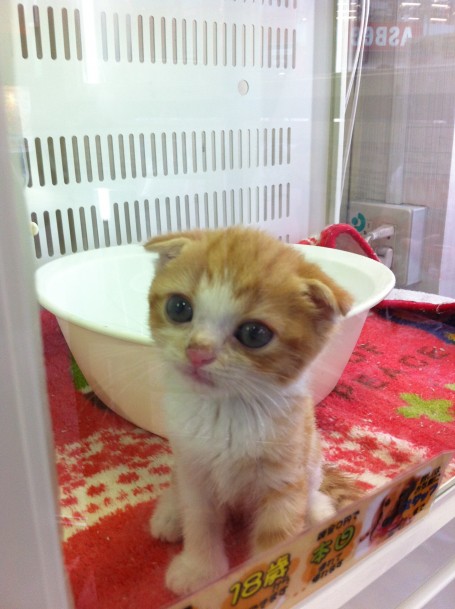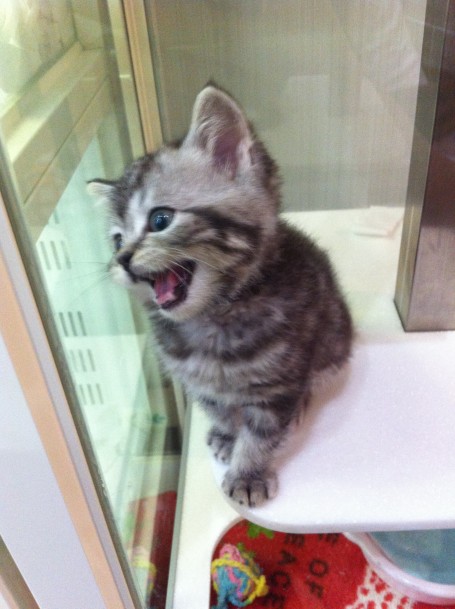By Sophia Mostowy and Leila Wang
To learn more about Japan’s international relationships, we stepped outside of our normal classroom in Liberty Tower at Meiji University for a field trip to Yokohama! Just before 10am, we met up with a few of the Meiji students and left for about a 40-minute train ride. It was a little overwhelming how confusing the train stations were with the multiple floors and countless number of corridors, but we were all able to make it through with some guidance. Although the train ride was long, it allowed for some enlightening conversations with some of the Meiji students about things like roller coasters, the prohibition of biking to elementary school, and the difference between combini (コンビニ) in Japan and convenience stores in the United States.
Our first stop in Yokohama was the JICA Japanese Overseas Migration Museum. This museum documented multiple aspects of Japanese emigration and the lives of Japanese natives in other countries. Probably the most intriguing and memorable fact we learned was that the Japanese government promoted overseas emigration. It was also interesting to see how the Japanese were able to preserve their heritage while also incorporating aspects of the new dominant culture, most easily displayed in their food. However, acculturation was very difficult and unfortunately left many Japanese with identity crises; in their new countries, the emigrated Japanese yearned for the Japanese culture, but upon returning to Japan, they missed many of the aspects of their foreign country’s traditions. It was also heart-wrenching to listen to the personal stories and learn of the many hardships the Japanese endured while abroad, especially in America during WWII. Overall, the museum was an incredible hands-on experience that allowed for a personal connection and the type of educational experience that goes beyond the classroom.
We also learned that the new Cupnoodles Museum was close by, so we swung over there with the little time we had before our lunch reservation in Chinatown.
The creator of the museum was Nissin Food Products, a Japanese company known worldwide for the production of cup noodles. We had all tried Nissin cup noodles before, so we were all excited about what we would find in the museum. As we walked through the sliding glass doors at the entrance, we were surprised by its modern and minimalist interior, with white as its primary color and the extensive use of wooden floorboards and glass railings. The design was something we would expect for a contemporary art museum, not a cup noodle museum. Then we saw an extremely large replica of a container of the famous Nissin Cup Noodle with a super kawaii yellow chick perched adorably on top of it, and we simply could not resist taking pictures with it.
We proceeded to get our tickets, which cost 500 yen, and then we made our way to the second floor to explore the exhibit. The first thing we saw was the Instant Noodles History Cube, a room filled with a historical lineup of instant noodles produced by countries other than Japan. We were awed by the sheer number of the different types of instant noodles on display. According to the museum guide, there were about 3,000 types of instant noodles in the room. It definitely goes to show the popularity of instant noodles all around the world, not to mention the demand for innovative flavors.
After admiring and drooling over all the different types of instant noodles, we walked through the exhibition floor, which took us through the history of the invention of instant noodles. We learned about the innovative ideas of Momofuku Ando, the founder of Nissin and inventor of the first batch of instant noodles in the world. He even came up with Space Ramen, an instant noodle that can be eaten in weightless environments without danger of being scalded by the hot soup.
Other than showing the interesting history behind instant noodles, the museum also displayed a number of creative art pieces and sculptures.
We went up to the third floor and found that it was a Cup Noodle Factory where visitors were invited to create their own personalized cup noodles by choosing the soup base and ingredients. There were also colored markers lying around for people to decorate their styrofoam cups. Unfortunately we were not able to make our own personalized cup noodles due to time constraints, but it was still fun to observe how other people decorated theirs. In another room, there was a group of visitors having fun making their instant noodles from scratch. We stood outside the glass windows and watched them enviously.
As we walked around a little more, we found a bike outside the ramen restaurant inside the museum and thought it would be fun to take a picture in it.
Time flies by so quick when you are enjoying yourself, and before we knew it, it was time to go for lunch. As we made our way to Chinatown, we passed by a shop with a huge President Obama statue.
After the museums, we walked to Chinatown where we had lunch at a restaurant named Chunking Chinese Szechuan Restaurant. Both of us ordered the “spicy” tan-tan noodles, which, like many of the other dishes we have had in Japan, weren’t very spicy. For dessert, we also ordered almond pudding, which is popular in China and Japan. It was an interesting experience to have Chinese cuisine with a Japanese twist to it, and the food was delicious.
After lunch, we had a little time to wander around Chinatown. A number of us stopped at SEGA, where we had some bonding time with the Meiji students playing an intense version of air hockey and Drum Master. Some of us also played UFO crane games in hopes of winning prizes.
We must note that it was a very blustery day! There is a typhoon approaching, and although it was not raining yet we had some very high winds. Therefore it was somewhat more difficult than usual to walk around to see many stores. So we stopped in only a few nearby stores and walked down one street where the wind was mostly blocked by the buildings. One of the stores we stopped in was completely panda themed! But the high winds were viciously shaking the windows, making the adorable store seem a little less inviting. We also explored a store with many tiny, intricate trinkets and a wide variety of dried fruit. I had never had dried kiwi before, and since it is important to keep an open mind while in another country – and also because it looked delicious – I bought some and tried it. It was not what I had been expecting, but it was still quite tasty.
Due to the orientation of the buildings along one of the streets, the winds were especially strong, so much so that an older man’s hat blew off and flew high through the air for a couple of blocks before landing in a hard-to-reach area to the side of one of the tall buildings. Following the immense politeness and generosity we have been shown during our entire stay in Japan so far, Matt retrieved the hat, saving it. The man was so grateful!
Since it was getting late, we decided to make our way back to Tokyo from Yokohama to avoid rush hour. Some of us stopped at Shibuya on the way home for a little more shopping. We went to Center Gai, which is a famous shopping street in Shibuya with many shops lining the walkways that caters mainly to younger crowds. Indeed, we saw many teenagers in their school uniforms hanging around, enjoying themselves on a weekday afternoon after school. As we shopped around, we came across a pet shop selling the most adorable kittens and puppies we had ever seen. Although the shop was crowded with people swooning over the adorable pets, we persevered and managed to elbow our way into the shop to take close-up pictures of the kawaii pets on display.
We were reluctant to leave the shop, but it was getting dark and we had to return to the hotel to prepare for class the next day. So, determined to come back another day to take more photos, we made our way home to Sakura Hotel in Jimbocho.

